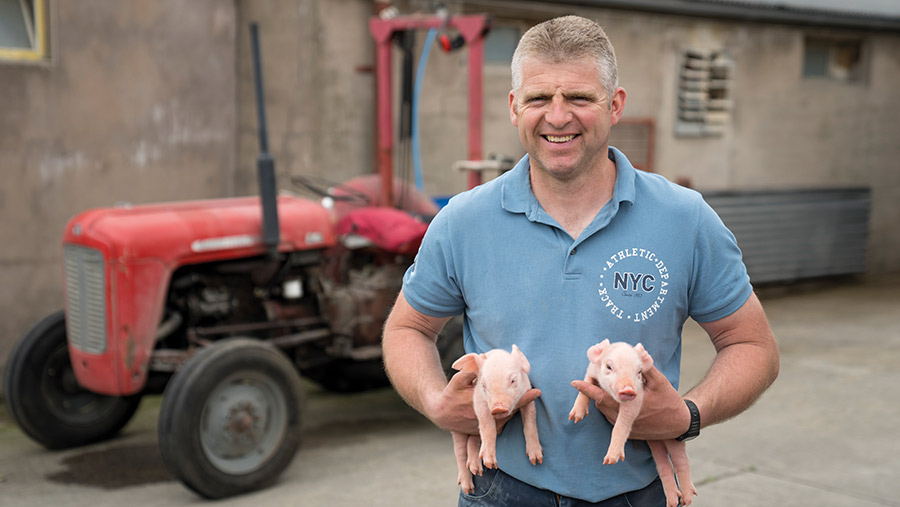How gilt ration tweaks are helping improve pig litter size
 © Steffan Hill
© Steffan Hill Focusing on the small details is one of Northern Irish farmer David Fulton’s winning ways and it is this approach that he hopes will help him increase litter size, by making minor changes to gilt rations.
With an average litter size of 17.7, and an average gilt litter size of 15.2, David says his gilts are a piglet short of where he wants them to be.
Last summer he began to look at the diet of gilts from selection to try to improve this. “My finishing pigs were all very lean and so were the gilts,” he explains.
See also Farmers Weekly Awards 2022: Pig Farmer of the Year
Fat depth on the gilts was only about 12mm using the P2 measurement, which was too lean, he says.
“Since we changed the nutrition, they’re now about 14-15 [mm]. This is optimum – that’s where we like them to be at. Then they’re served at 160kg at 240 days.”
Ration tweaks
All rations are milled by David on farm to ensure quick changes can be made when needed.
The mechanics of the changes to the gilt diets were decided by David and his nutritionist, Ultan Keady, from Cargill Nutrition.
The base of the ration stayed the same – centred around barley, maize and wheat – but inclusion rates were altered.
“We lowered the protein. Whenever we’re formulating rations now, we’re trying to lower protein where we can [for environmental and health reasons]. [We also] increased oil and digestible energy.”
Farm facts
- 65ha (160-acre) site in Northern Ireland
- 180-sow birth-to-bacon unit
- Closed herd with all gilt replacements bred on farm
- Using Danish genetics
- 120-head herd of beef and a 400-head flock of Mule cross Texel sheep
Digestible energy rates went from 13.2MJ/kg to 13.6MJ/kg and soya oil was increased from 0.7% to 2%.
Protein content was lowered from 14% crude protein to 13.2%. Small alterations were made to mineral supplementation, too. The aim of all these changes is to help gilts lay down more condition ahead of service.
Boar management has been altered, too. David now uses altresyn to synchronise heat cycles, feeding it to pigs and then limiting boar contact for 18 days. After this time, the boar is brought back in – at which point all gilts should be in synch.
The new ration is now fed to gilts from selection through to service, with the first gilts on the new regime set to farrow soon, explains David.
“Hopefully now with these changes, and the gilts in better condition, this should increase average gilt born live [numbers].”
Emissions endeavours
With an eye on reducing emissions associated with the entire farm business, David has invested in a new Abbey tanker and dribble bar system for spreading slurry to replace his previous splash-plate applicator.
“Using the dribble bar, compared with the traditional splash plate, creates 30% less ammonia emissions – that’s a big thing for us here at the minute.”
Trials show this system results in fewer nitrogen losses and more nutrients in the ground, meaning it may be possible to reduce reliance on synthetic fertilisers.
This is something David has already noted on his own farm, with slurry spread across the 65ha (160 acres) of grassland.
“We don’t use a lot of fertiliser anyway because we have the slurry,” he explains.
Normally, about 12t is used, but last year David reduced this by 2-3t and is hoping to cut that further this year.
Another 300m of hedges are also being planted this year as part of the farm’s ongoing environmental commitments.
The Farmers Weekly 2023 Pig Farmer of the Year
David Fulton was Farmers Weekly’s Pig Farmer of the Year 2022.
Enter yourself or nominate someone for this award or one of the other categories for our 2023 awards on our Awards website
